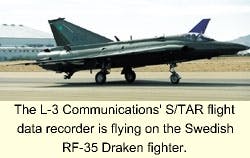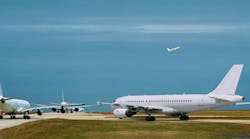By John McHale
CAMDEN, N.J. - Engineers at Recon/Optical Inc. in Barrington, Ill., recently replaced a tape device with a solid-state recorder from L-3 Communication Systems-East on their CA-260 electro-optical framing sensor, during flight tests of the Swedish RF-35 Draken fighter at the Mojave, Calif., airport.
L-3's Airborne Solid State Recorder, the S/TAR (Strategic/Tactical Airborne Recorder), performed its flight certification test on the Draken from Saab Aerospace in Linkoping, Sweden. The S/TAR is a high-performance solid-state recorder for severe-environment applications in reconnaissance and flight testing.
This flight test involved a tactical reconnaissance mission, with near-real time imagery dissemination. The Draken collected images from several tactical targets using the CA-260. Experts view the images after the flight on a Recon/Optical reconnaissance exploitation ground system. This test demonstrated an end-to-end imagery collection and dissemination capability of L-3's solid-state recorder.
Solid-state recorders have many advantages over tape, says Russ Prechtl, S/TAR business and development manager at L-3. Devices like S/TAR have no moving parts, low maintenance cost, small size, and low weight and power consumption, he explains. Plus the mean time between failure (MTBF) for tape is about 1,000 hours, while the MTBF for solid-state devices is approximately 10,000 hours, Prechtl claims.
The high-volume use of FLASH memory in the commercial world has also brought down the price of solid-state memory to compete with the cost of tape technology, Prechtl says. In fact, solid-state FLASH memory now costs less than tape, he claims.
Installation of the visible reconnaissance system was in a 5.6-cubic-foot avionics bay, of which S/TAR occupied 0.86 cubic feet. This flight test used DCRSi tape recorder protocol, and validated the S/TAR product as a viable "plug and play, flight-proven" replacement for the Ampex DCRSi tape recorder, L-3 officials claim. This will provide enhanced capabilities and improve operational mission performance on reconnaissance platforms, they say.
The Ampex device took up 1.7 cubic feet, making S/TAR half its size, Prechtl says. The L-3 device can resist temperatures down to -54 degrees Celsius, while tape can go to 10 degrees C, he claims.
The L-3 recorder also successfully survived a variety of operating temperatures, altitudes, vibration, and humidity levels during the flight test, L-3 officials claim.
The S/TAR system facilitates either physical memory cartridge removal or data transmission via a wideband datalink in near-real time. An operator may also review imagery while simultaneously recording new imagery from several different sensors.
S/TAR features include 400-megabit-per-second data rates, and 100-gigabit storage capacity. The device also offers a cartridge architecture with Reed-Solomon Error Detection and Correction.
The life cycle is every 12 to 18 months for storage capacities to double, Prechtl says. L-3 should be able to double the Draken S/TAR device's capacity in the same form factor within that time, Prechtl explains.
All S/TAR circuit modules are in the 6U 160-millimeter avionics form factor and use standard VME and RACEway backplanes. L-3's product offerings support embedded S/TAR circuit modules within a shared VME nest.
L-3 is working to get S/TAR on the U.S. Navy Shared Reconnaissance Pod (SHARP), the Navy's F-18E and F fighter-bombers, the Global Hawk unmanned aerial vehicle, and the U.S. Air Force F-22 fighter, Prechtl says.
For more information on the S/TAR recorder contact Russ Prechtl by phone at 703-412-7190, by email at [email protected], or on the World Wide Web at http: www.l-3com.com.
null



